Proudly Serving The Greater Indiana Area Since 1978
Basements are great for storage, extra living space, or even that home gym you’ve been thinking about—but when water gets in, it can turn your lower level into a costly mess. Whether it’s a little dampness or full-on flooding, basement waterproofing is how you protect your Indianapolis area home (and your sanity) from serious damage.
At EverDry Waterproofing of Greater Indiana, we’ve seen it all—leaky walls, puddles forming after heavy rain, and mold creeping into crawl spaces. The good news? There are proven methods that can solve your water problems for good. Let’s look at the most popular ones and what might work best for your house.

No two basements are exactly alike. That’s why waterproofing needs to be tailored to your foundation, your home’s age, and what kind of water issues you’re dealing with. Here are five of the most common basement waterproofing methods we use to help homeowners get back to a dry basement.
If water is seeping in from the outside ground, exterior waterproofing is a smart investment. This method stops moisture before it even has a chance to reach your foundation walls.
What it involves:
This is especially useful if you’ve had repeated flooding or water infiltration during storms. It’s a more extensive process, but when done right, it can last for decades.
For wet basements that don’t involve flooding but do have leaks, interior waterproofing may be all you need. It’s less invasive than exterior work and can help prevent future problems.
Here’s how it works:
This method doesn’t stop water from entering the exterior wall, but it helps control and redirect it so it doesn’t damage your property.
Ask anyone who’s had a flooded basement—a good sump pump can save you thousands. If water tends to collect at your home’s lowest point, a sump pump helps by pumping it out and away from your foundation.
Why it matters:
We recommend installing a battery backup sump pump, too—just in case the power goes out during a storm.
Water on your basement floor is more than a nuisance—it can lead to mildew, wood rot, and structural damage. An interior drainage system gives water a place to go, fast.
This includes:
This method works especially well in older homes where exterior waterproofing isn’t feasible.
If your basement walls feel damp or musty, a waterproof coating may be part of the solution. While not a fix for major leaks, coatings help with moisture control and surface-level dampness.
What they do:
They’re often used after repairs to add an extra layer of protection and improve the feel of the space.
We get it—you’re handy. And there’s no shortage of DIY basement waterproofing kits on the market. But when you’re trying to protect your foundation and prevent water damage, it’s best not to gamble.
Here’s why DIY often falls short:
Our team has decades of experience solving tough water problems across Indianapolis and Central Indiana. We don’t offer one-size-fits-all fixes—we give you a tailored plan, financing options, the best waterproofing products, and support for the entire process.
If you’re seeing signs of seeping, dampness, or just want peace of mind, it’s time to bring in the professionals. At EverDry Waterproofing of Greater Indiana, we start with a free inspection and detailed evaluation. No guesswork—just real answers and options that work for your home construction, your budget, and your goals.
We’ve been helping homeowners protect their homes since 1978. Our expert team knows how to identify the main source of the problem and provide the right basement waterproofing solution for your unique home.
Schedule your free basement inspection today to get started!
Everdry of Greater Indiana offers multiple solutions so you can be
sure to find the perfect one for your home!

Put an end to dampness, cracks, bowing walls, mildew and musty smells with the Everdry Solution.

Put an end to dampness, cracks, bowing walls, mildew and musty smells with the Everdry Solution.

Put an end to dampness, cracks, bowing walls, mildew and musty smells with the Everdry Solution.
Specializing in Basement Waterproofing, Crawlspace Waterproofing and Foundation repair.

5201 W Pike Plaza RdIndianapolis, IN 46254